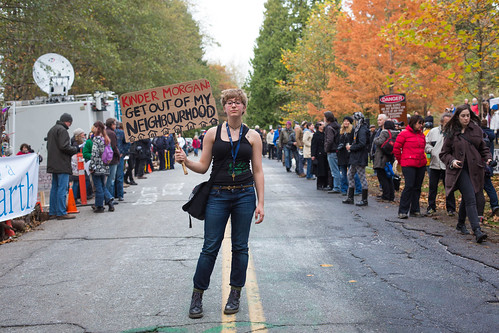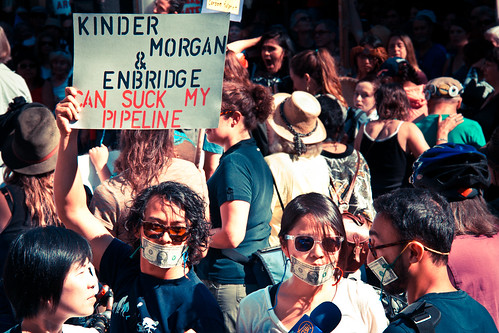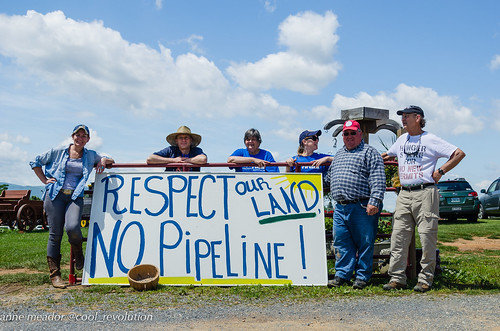Pipeline resistance has become a hallmark of the people-powered movement to stop the expansion of the oil and gas industry, a movement led by Indigenous groups, private landowners, ranchers, and affected communities.
Some of these battles have become iconic, and they’re certainly not over. Hearings are taking place in Nebraska over Keystone XL this week, and Indigenous leaders continue to fight Dakota Access in court. But there are more pipelines just like them in the works and they have one big thing in common — motivated, organized resistance.
Here are six pipelines you need to know about.
1. Kinder Morgan’s TransMountain Pipeline
The TransMountain pipeline (sometimes just called the Kinder Morgan pipeline for its parent company) is one of two tar sands oil pipelines currently planned in Canada, each of which would ship nearly 1 million barrels of the world’s dirtiest crude per oil per day. The TransMountain cuts across Alberta and British Columbia, and would make the gorgeous Salish Sea and the U.S. Pacific Northwest an oil tanker superhighway if completed.
TODAY: activists blocked construction of Kinder Morgan's fracked gas pipeline in MA. https://t.co/DF59HdLs8e @SugarShack413 #ResistOften pic.twitter.com/3F3ssVjmeD
— Greenpeace USA (@greenpeaceusa) May 2, 2017
With construction set to begin this fall, the project has already been hugely controversial in British Columbia, where it was a major topic in provincial elections.
2. Enbridge’s Line 3 Replacement
Along with Kinder Morgan and KXL builder TransCanada, the other player in the tar sands pipeline game is Enbridge. A recent Greenpeace report shows that Enbridge has historically been the dirtiest, most spill-prone of the three. Despite that, the company just started construction on its Line 3 Replacement pipeline on both the Canadian and Wisconsin sides of Lake Superior. Enbridge is yet to secure the permits to build through Minnesota, where the pipeline is supposed to run for more than 300 miles.
Like TransMountain and KXL, the Line 3 Replacement is in blatant violation of tribal and First Nations rights, so — like so many other critical pipeline fights around the country — Indigenous alliances are leading the coalitions resisting the construction of these dangerous projects.
3. The Atlantic Coast and Mountain Valley Pipelines
Right now, a huge build-out of fracked natural gas pipelines is slowly creeping across the country — and it’s booming in the Northeast, home to the Marcellus and Utica shales.
The Atlantic Coast and Mountain Valley pipelines would stretch south from the Marcellus Shale in West Virginia, bringing billions of cubic feet of natural gas through Virginia and (in the case of the Atlantic Coast pipeline) deep into North Carolina.
In addition to the dangers a natural gas spill poses along the pipelines’ routes, any investment in more fracking is simply a cost our climate cannot afford. Far from the “bridge fuel” the oil and gas industry suggests it is, fracked natural gas is more expensive, more polluting, and more dangerous than renewable energy.
4. The Mariner East Pipeline
It’s difficult to choose just one more, as gas pipelines are being installed (and resisted and even stopped) at astonishing rates through Ohio, Pennsylvania, New Jersey, New York state and even Manhattan.
Resistance goals! Meet the mother-daughter duo fighting Pennsylvania's largest pipeline project. https://t.co/yqqOdh827s #ResistOften pic.twitter.com/Ll2EbBHzZe
— Greenpeace USA (@greenpeaceusa) April 25, 2017
One project that is getting less attention than it deserves, however, is Mariner East, which is actually two separate pipelines carrying products east from the Marcellus Shale through Pennsylvania. Currently, a tree sit at Camp White Pine — a site on a farm in the path of Mariner East 2 — is demonstrating the power of direct action by a few dedicated resisters to delay pipelines.
5. Energy Transfer Partners’ Bayou Bridge Pipeline
You’ve probably heard of Energy Transfer Partners, the company with Trump ties behind the Dakota Access Pipeline. But you may not have known that it’s also trying to build an oil pipeline through territory belonging to the Houma Nation that would also threaten the water source for hundreds of thousands of people.
Today we build: indigenous peoples, environmental justice communities, & many allies, in prayer & resistance. #NoBayouBridge #WaterIsLife pic.twitter.com/CPYXK35nOA
— Leau Est La Vie Camp (@NoBayouBridge) June 24, 2017
Some of the boldest leaders in the Gulf climate justice movement have come together to start “L’eau Est la Vie” camp to resist Energy Transfer Partners and the Bayou Bridge Pipeline
6. Plains All American’s Diamond Pipeline
The Diamond Pipeline would transport Texas crude oil 440 miles across Oklahoma and Arkansas to the Valero refinery in Memphis, Tennessee. It would cross 500 wetlands and five major drinking water sources.
The Oklahoma Coalition to stop the Diamond Pipeline has established the Oka Lawa Camp south of the Arkansas River on Choctaw land.
— Ruth H. Hopkins (@RuthHHopkins) March 12, 2017
To make matters worse, Plains All American is one of the sloppiest companies in the business — responsible for a 100,000-gallon spill off the coast of Santa Barbara in 2015, among others. A grassroots campaign to battle the Diamond Pipeline includes groups like BOLD Oklahoma, Arkansas Rising, Clean Water Memphis, and two Indigenous-led resistance camps in Oklahoma: Oka Lawa and Wealaka.
How you can join the movement to put people before pipelines.
Stopping these dangerous pipelines that violate the rights of those in their path and investing in clean, renewable energy is our only option if we’re going to stop runaway climate change. And whether or not these pipelines are a direct threat to your community, more fossil fuel infrastructure is bad news for all of us.
And that means it’s up to all of us to take action — start by putting pressure on the banks that continue to finance these disastrous projects. Click below to tell JPMorgan Chase to defund tar sands oil pipelines like Keystone XL, Kinder Morgan, and Enbridge Line 3!






